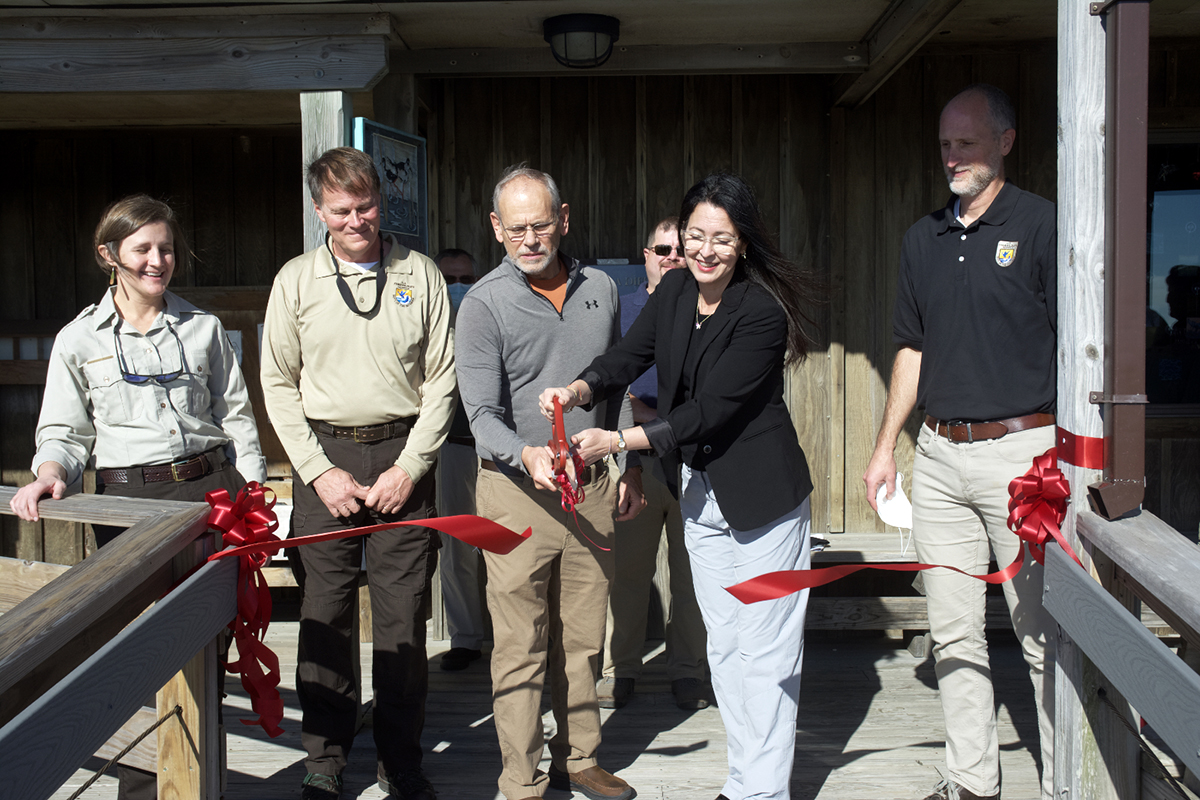
A part of the visitor experience, the visitor center at the Pea Island National Wildlife Refuge had become increasingly at risk from storm surge and ocean overwash. Having opened in 1995, the harsh climate of the Outer Banks had made renovations, which were completed last year, a critical need.
The project completion was celebrated during a ribbon cutting Friday and unveiling of the visitor center’s new flooring, updated display and retail space and, perhaps most importantly, the structure’s new higher elevation 5 feet above ground.
Supporter Spotlight
Pea Island and Alligator National Wildlife Refuge Manager Scott Lanier described during his opening remarks the importance of elevating the building to help protect it.
“We’re always keeping a watchful eye on the future and thinking about how and where we will be for our visitors,” he said. “For the many visitors who pass through and do not yet know what a national wildlife refuge is, to the folks who hold in a special place in their hearts and return annually … I’m confident that for many years to come, because we’re raising this building, we can meet them right here.”
The renovation was joint project with the Coastal Wildlife Refuge Society, the nonprofit that supports northeastern North Carolina national wildlife refuges, and Lanier called particular attention to their efforts.
“Former Visitor Services Manager Bonnie Strawser launched a fundraising campaign to elevate the building. Over $25,000 was donated to the cause,” Lanier said, also drawing attention to the hours of volunteer labor that went into raising the building and improving it.
The ribbon cutting was a delayed celebration. Renovations were completed in spring 2020, but COVID-19 restrictions prevented the reopening.
Supporter Spotlight
The delay, though, did allow Lanier to address what he said are improving conditions for the Pea Island and Alligator River national wildlife refuges.
The keynote speaker for the ribbon cutting was Interior Department Assistant Secretary for Fish and Wildlife and Parks Shannon Estenoz. Accompanying her was Deputy Regional Director Mike Oetker, and Lanier went out of his way to praise them.
“I’ll say this with all sincerity, after spending time with Shannon and Mike yesterday, I can’t remember when I’ve been more inspired about what I’m doing and what you are doing and how you’re helping us,” he said. “It was a shot in the arm.”
In her comments, Estenoz drew attention to the importance of the wildlife refuge system.
“You’re really at the intersection of what so many of our refuges are trying to do,” she said. “You’re at the forefront of climate change. You’re right on the leading edge here trying to protect wildlife, trying to protect important coastal resources and then offering to the public ways in which they can come and be on their public lands and enjoy public lands and understand the important role that they play in American life.”
She also noted the long-needed investments in the Fish and Wildlife Service that the federal government is preparing to make.
“I think we can take hope from the passage of the bipartisan infrastructure law that President Biden (signed) into law,” Estenoz said. “This is a generational investment in the resilience of both national infrastructure and hard infrastructure … for this country.”
A native of Key West, Florida, Estenoz’s background is in civil engineering, and she made it clear she understands how tenuous the N.C. 12 highway connection is.
“This feels really familiar, like a very familiar challenge. I know how challenging it is, because I know how costly these kinds of investments can be. But I don’t think of them as costs. I think of them as investments,” she said.
Estenoz, in response to reporters’ questions after the ribbon cutting, also noted the importance of the Great American Outdoors Act, another bipartisan measure signed into law during the Trump administration.
“That’s a 2020 piece of legislation that was also a generational investment in land acquisition and protected areas. I think you’ll see all over the refuge system additional acquisitions, bringing more lands into the refuges. And secondly, there’s also a big infrastructure component there, and that is to address some of the deferred maintenance of the infrastructure that we were under-invested in,” she said. “That’s been going on for some time.”
The need for updated, improved and expanded refuges is valuable, she explained, in helping people understand the importance of environmental stewardship.
“To be out here, to see the landscape and the wildlife. It’s a place where people learn what it’s like,” she said. “There’s no substitute. In that respect, these are invaluable places.”







